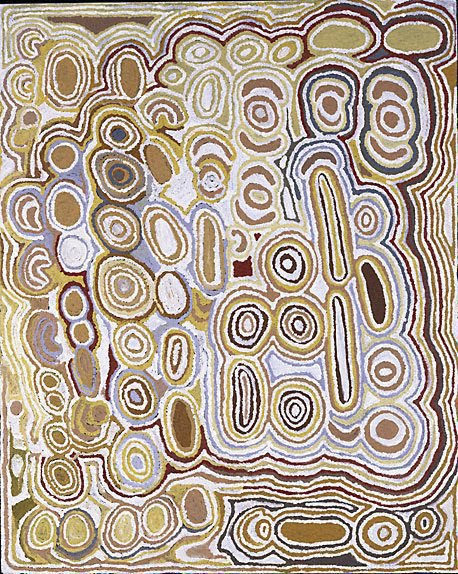Title
Watanuma, from the suite Tjukurrpa Palurukutu, Kutjupawana Palyantjanya - same stories, a new way
2009
Artist
-
Details
- Place where the work was made
-
Papunya
→
Northern Territory
→
Australia
- Date
- 2009
- Media category
- Materials used
- etching on Hahnemühle rag paper
- Edition
- 1/40
- Dimensions
- 33.0 x 25.0 cm platemark; 55.0 x 45.0 cm sheet
- Signature & date
Signed l.r. beneath platemark with artist's mark, pencil "X". Not dated.
- Credit
- Purchased with funds provided by the Aboriginal Art Collection Benefactors 2011
- Location
- Not on display
- Accession number
- 421.2011.5
- Copyright
- © Wintjiya Napaltjarri. Licensed by Aboriginal Artists Agency Ltd
- Artist information
-
Wintjiya Napaltjarri
Works in the collection
- Share
-
-
About
In addition to showcasing the quality of Papunya Tula Artists as a whole, this suite of etchings emphasises the strength of each individual artist as they successfully translate their Tjukurrpa to the new medium of printmaking. Far from being a mere copy of their paintings in a different scale and medium each artists adapts their visual language to this new process with apparent ease, resulting in bold, confident works that are extraordinary in themselves, and when combined as a suite, are truly amazing.
The art centre documentation for this work states:
The design in this etching relates to the site of Watanuma, north-west of the Kintore community. A group of ancestral women gathered at this site to perform the dances and sing the songs associated with the area. The women also spun hair-string for making hair-string skirts which are worn during ceremonies. The nyimparra (hair-string skirts) are depicted in the etching by the straight line with adjacent shorter lines. Upon completion of these ceremonies the women continued their travels towards the east to the rockhole site of Malparingya and later further east to Pinari, also north-west of Kintore. As they travelled the women gathered large quantities of the edible fruit known as pura (also known in Pintupi as pintalypa) or bush tomato from the small shrub Solanum chippendalei. This fruit is the size of a small apricot, and after the seeds have been removed, can be stored for long periods by halving the fruit and skewering them onto a stick.
-
Places
Where the work was made
Papunya
-
Exhibition history
Shown in 1 exhibition
Papunya Tula works on paper, Art Gallery of New South Wales, Sydney, 13 Dec 2012–24 Mar 2013




